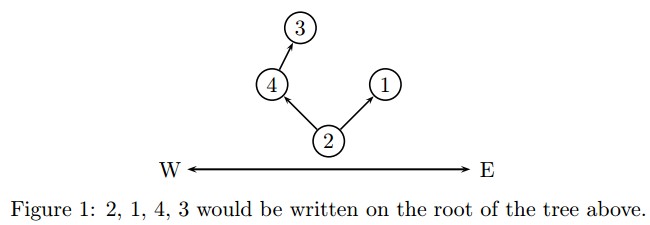Elven Postman
Time Limit: 1500/1000 MS (Java/Others) Memory Limit: 131072/131072 K (Java/Others)
Total Submission(s): 2500 Accepted Submission(s): 1478
Problem Description
Elves are very peculiar creatures. As we all know, they can live for a very long time and their magical prowess are not something to be taken lightly. Also, they live on trees. However, there is something about them you may not know. Although delivering stuffs through magical teleportation is extremely convenient (much like emails). They still sometimes prefer other more “traditional” methods.
So, as a elven postman, it is crucial to understand how to deliver the mail to the correct room of the tree. The elven tree always branches into no more than two paths upon intersection, either in the east direction or the west. It coincidentally looks awfully like a binary tree we human computer scientist know. Not only that, when numbering the rooms, they always number the room number from the east-most position to the west. For rooms in the east are usually more preferable and more expensive due to they having the privilege to see the sunrise, which matters a lot in elven culture.
Anyways, the elves usually wrote down all the rooms in a sequence at the root of the tree so that the postman may know how to deliver the mail. The sequence is written as follows, it will go straight to visit the east-most room and write down every room it encountered along the way. After the first room is reached, it will then go to the next unvisited east-most room, writing down every unvisited room on the way as well until all rooms are visited.
Your task is to determine how to reach a certain room given the sequence written on the root.
For instance, the sequence 2, 1, 4, 3 would be written on the root of the following tree.

Input
First you are given an integer T(T≤10) indicating the number of test cases.
For each test case, there is a number n(n≤1000) on a line representing the number of rooms in this tree. n integers representing the sequence written at the root follow, respectively a1,...,an where a1,...,an∈{1,...,n}.
On the next line, there is a number q representing the number of mails to be sent. After that, there will be q integers x1,...,xq indicating the destination room number of each mail.
Output
For each query, output a sequence of move (E or W) the postman needs to make to deliver the mail. For that E means that the postman should move up the eastern branch and W the western one. If the destination is on the root, just output a blank line would suffice.
Note that for simplicity, we assume the postman always starts from the root regardless of the room he had just visited.
Sample Input
2
4
2 1 4 3
3
1 2 3
6
6 5 4 3 2 1
1
1
Sample Output
E
WE
EEEEE
在题目描述中应该能够看出,这是一个搜索二叉树,即右孩子大于根节点,左孩子小于根节点具有严格结构的二叉树,在这种二叉树中,我们可以通过递归的写法,把二叉树各个节点进行赋值,并不断扩充新的节点
#include<cstdio>
#include<algorithm>
#include<cstdlib>
using namespace std;
struct edge
{
int date;
edge *left;
edge *right;
};
void sovle(edge* &root, int x);//插入节点,构建二叉树的函数
void find(edge* &root, int y);//搜寻节点的函数
int main(void)
{
int t;
scanf("%d", &t);
while(t--)
{
int n, m, i;
edge* root = NULL;//首先需要有一个节点作为二叉树的根节点
scanf("%d", &n);
for(i = 0; i < n; i++)
{
int x;
scanf("%d", &x);
sovle(root, x);//插入每一个节点
}
scanf("%d", &m);
for(i = 0; i < m; i++)
{
int y;
scanf("%d", &y);
find(root, y);//搜寻每一个节点
printf("\n");
}
}
return 0;
}
void sovle(edge* &root, int x)
{
if(root == NULL)
{
root = new edge;//将叶子节点扩充成为一个具有左右孩子的根节点
root->date = x;
root->left = NULL;
root->right = NULL;
}
if(root->date > x)
{
sovle(root->left, x);//如果要插入的数小于根处的值,那它一定在根的左边
//不一定是左孩子,可能更深
}
if(root->date < x)
{
sovle(root->right, x);//如果要插入的数大于根处的值,那它一定在根的右边
//不一定是右孩子,可能更深
}
}
void find(edge* &root, int y)
{
if(root->date < y)
{
printf("W");
find(root->right, y);
}
else if(root->date > y)
{
printf("E");
find(root->left, y);
}
}